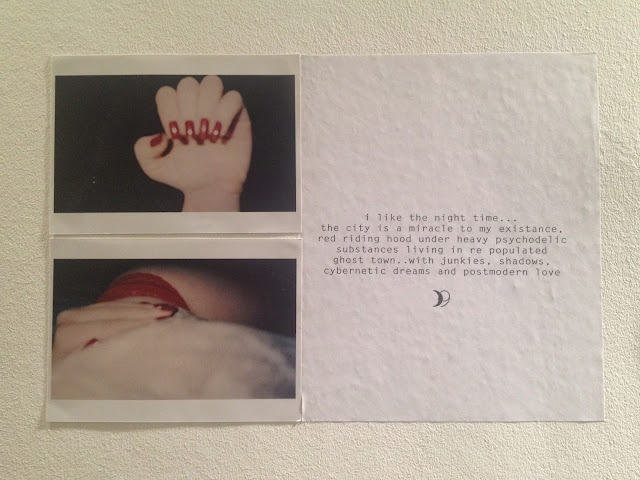‘All of the summer was chaotic, lots of
things have happened and it has left them in the middle- vague, uncertain. All
those feelings and sensations have stayed with us till October, we still live
in summer. This summer was immensely inspirational and all the stuff we went
through during it’-hence the Summer Leftovers in the Frontline
café as Maksime Machaidze, the curating artist explains. The Stupid Kid Factory
is a collective of very young and interesting people. Most of them are
teenagers producing very promising art- good quality, lyrical and unexpected.
Often ignoring the specificity of Georgia, these kids could have easily been
from anywhere in Europe, which might as well be a compliment for the society
where moving out of the house and any attempts of being independent before
marriage are not welcome to say the least.
The hero of the evening, Maksime, in a
red hat and the shirt – Tripping into darkness has an undeniable
charm in his restless moving, expressive talking and the passion while mixing
the music. He is the soul of the Stupid Kid Factory; gathering the group, it is
almost always him who comes up with the conception and then organises events.
As Maksime calls it, he ‘just happened to have all the qualities for bringing
stuff together’ and indeed there are no hierarchies in the Stupid Kid
Factory-‘These are not the people who would let me choose their art- it would
be absurd and there would be no synthesis. All of us know what we like and what
not. I just do the final touches sometimes.’ Filled with childish boldness, on
the edge of impudence, Maksime is definitely too young to be so mature. Not
acknowledging any educational institutions, he works on himself. ‘They
don’t teach in the academy; they don’t teach anywhere. In my opinion the
academy even harms the kids. The ones that don’t have a very firm stance and
attitude are instantly converted to their ideology which is quite problematic.’
This approach shared by the majority of creative teenagers leaves the academy
devoid of some thrilling names.
Anka Bochorishvili’s drawings were
definitely the discovery of the evening; accurate and precise, almost like a
jeweler's work, the illustrations of the circus freaks on their breaks are
striking compositionally and aesthetically; and of course the stunning
craftsmanship. The mood of solitary figures with their heads bent down in the
process of eating somehow communicate the sensation of quiet solitude, exhaustion
and the melancholy of the autumn. The popular twisting of the circus clown’s
persona into a depressive character is perfectly infused with Japanesque
aesthetics. Japanese engravings, her sole inspiration are nicely reflected in
her art. The Spaceships and Pilots series was inspired by the
anime Cowboy Bebop.
Qeu has presented a series of photos
from her summer accompanied with the quotes by Jack Kerouac’s On the
Road. The shots from her trips tie into the autobiographical sense of the
book. Indeed, the art these kids produce is indispensable from their
everyday lives, their friends and the environment they dwell, just like
Kerouac’s On the Road. ‘We’ve spent all of the summer together and
everything exhibited here, we’ve created together’ says Qeu explaining the same
faces and silhouettes peering from the photos. ‘There was nowhere to
go but everywhere, so just keep on rolling under the stars’- one of the series
is called. But even more so, it exemplifies the unattainable desire of soaking
in the world around and transforming it into art that these kids share.
The most memorable trip to
Taniantkaari, as Qeu describes it, creates the series of Stars, painting
the mood that long stays with the viewer. The warmth of the fire drawing the
abstract shapes and the blur of the captions give a very precise idea about the
fun of the evening, leaving the viewer slightly jealous they weren’t there.
Focused on the truthfulness of the sensations and experiences these kids go
through, none of them edits their photos, nor does Qeu.
A first-year student of Psychology,
Ninka wants to be a make up artist, but in the meantime she has exhibited
photos and the ones taken this summer are particularly interesting.
Acknowledging the importance of the text in the photography, the team decided
Maksime would annotate the photos- actually, create stories for the shots. The
twin captions of the mundane, neglected or the loved accompanied by texts,
unleashing the sensuality of the shots. Ninka even thinks the seemingly
unimportant details such as a date or the location are vital for apprehending
the photo and creating a story of your own- in here the spectator’s work is
done by Maksime- maybe to win the hearts of photography skeptics.
As for Maksime’s actual art, he has
exhibited the customised skateboards and clothes, prints on wood, leather and
paper. ‘This is the art that I myself would love to hang on my wall. I love
hip-hop music and I have been listening to it all of the summer. I decided to
pick out the summer soundtracks and the quotes from there. This is not
something I’ve spent ages thinking about, but something I know is visually
correct. This is the ideology that I support and put into my aesthetics. My
attitudes and personal opinions were secondary in this case.’

As these artists are only beginners it
was particularly promising to catch some of the positive trends- that Qeu
brought in and has integrated the book that is acknowledged as
classics; that Ninka is a psychology student that wants to become a make-up
artist who also makes art; that Maksime manages to be the curator as well as
being an artist, write music and texts; that he does not believe in educational
institutions and at the age 18 he is able to notice the fundamental problems in
them; that both Ninka and Qeu use analogue instead of digital and never edit
their photos in Photoshop.



















No comments:
Post a Comment